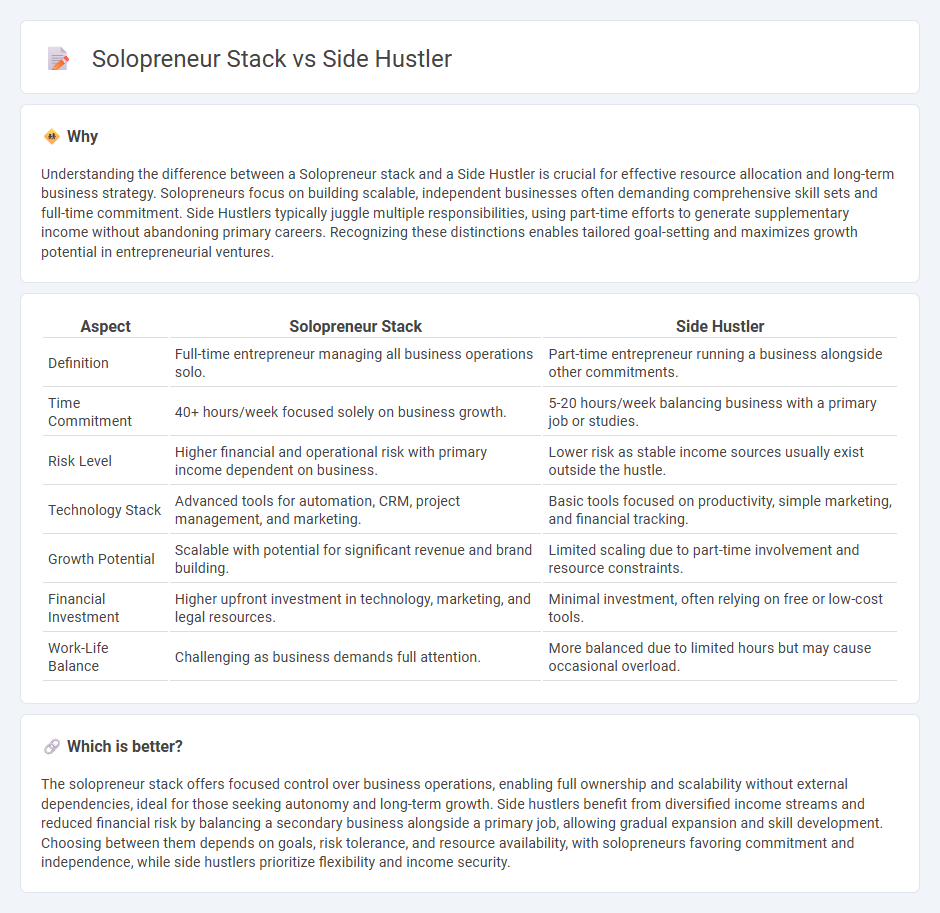
Solopreneurs fully commit to building independent businesses as their primary source of income, leveraging dedicated resources and strategic planning to scale and sustain growth. Side hustlers, on the other hand, pursue entrepreneurial ventures alongside other jobs, balancing limited time and capital to test ideas and generate supplementary revenue. Explore key differences and strategies to determine which entrepreneurial path aligns best with your goals.
Why it is important
Understanding the difference between a Solopreneur stack and a Side Hustler is crucial for effective resource allocation and long-term business strategy. Solopreneurs focus on building scalable, independent businesses often demanding comprehensive skill sets and full-time commitment. Side Hustlers typically juggle multiple responsibilities, using part-time efforts to generate supplementary income without abandoning primary careers. Recognizing these distinctions enables tailored goal-setting and maximizes growth potential in entrepreneurial ventures.
Comparison Table
| Aspect | Solopreneur Stack | Side Hustler |
|---|---|---|
| Definition | Full-time entrepreneur managing all business operations solo. | Part-time entrepreneur running a business alongside other commitments. |
| Time Commitment | 40+ hours/week focused solely on business growth. | 5-20 hours/week balancing business with a primary job or studies. |
| Risk Level | Higher financial and operational risk with primary income dependent on business. | Lower risk as stable income sources usually exist outside the hustle. |
| Technology Stack | Advanced tools for automation, CRM, project management, and marketing. | Basic tools focused on productivity, simple marketing, and financial tracking. |
| Growth Potential | Scalable with potential for significant revenue and brand building. | Limited scaling due to part-time involvement and resource constraints. |
| Financial Investment | Higher upfront investment in technology, marketing, and legal resources. | Minimal investment, often relying on free or low-cost tools. |
| Work-Life Balance | Challenging as business demands full attention. | More balanced due to limited hours but may cause occasional overload. |
Which is better?
The solopreneur stack offers focused control over business operations, enabling full ownership and scalability without external dependencies, ideal for those seeking autonomy and long-term growth. Side hustlers benefit from diversified income streams and reduced financial risk by balancing a secondary business alongside a primary job, allowing gradual expansion and skill development. Choosing between them depends on goals, risk tolerance, and resource availability, with solopreneurs favoring commitment and independence, while side hustlers prioritize flexibility and income security.
Connection
Solopreneurs and side hustlers both embody entrepreneurial spirit by independently pursuing business ventures, often balancing multiple roles without traditional employment. Solopreneurs typically focus full-time on building scalable businesses, while side hustlers maintain a primary job and develop supplementary income streams in their spare time. Both leverage digital tools and flexible strategies to optimize productivity, foster innovation, and achieve financial autonomy.
Key Terms
Time Management
Side hustlers and solopreneurs both face unique time management challenges, with side hustlers juggling commitments alongside full-time jobs while solopreneurs dedicate all hours to their business. Effective prioritization, scheduling tools, and setting clear boundaries are critical strategies for optimizing productivity in each role. Discover tailored time management tips and tools to boost efficiency whether you are a side hustler or solopreneur.
Revenue Streams
Side hustlers often diversify income through multiple part-time ventures, creating varied revenue streams that stabilize cash flow and reduce financial risk. Solopreneurs typically concentrate on scaling a single business or niche market to maximize profit and brand authority. Explore the strategic advantages of each model to optimize your revenue streams effectively.
Scalability
Side hustlers prioritize flexible income streams that complement their primary job, often testing market demand before scaling operations. Solopreneurs invest heavily in building scalable business models capable of generating sustainable, long-term revenue with minimal overhead. Discover effective strategies to transition from side hustling to solopreneurship and maximize your scalability potential.
Source and External Links
27 Side Hustle Ideas for 2025 to Make $500+ in Your Spare Time - Provides diverse side hustle ideas including becoming an Amazon Influencer, cleaning services, and pet sitting, with examples of income potential and step-by-step challenges to start earning.
30 Side Hustle Ideas That Don't Need Experience (2025) - Shopify - Lists side hustles such as affiliate marketing and selling digital products, ideal for beginners looking to create income streams online without prior experience.
48 Side Hustle Ideas to Get You Started - Shares a wide range of ideas from renting baby gear to becoming an Amazon affiliate or starting a tour guide service, focusing on low-cost, flexible options for earning extra income.
 dowidth.com
dowidth.com